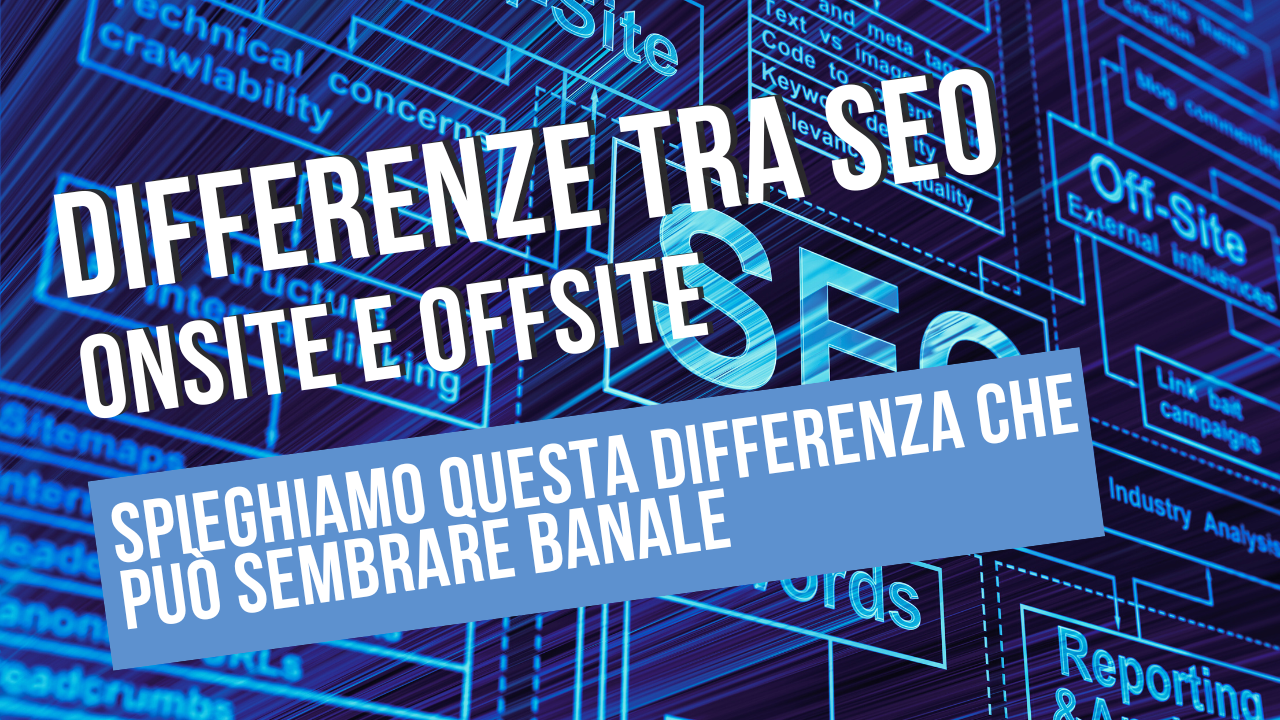The world of Search Engine Optimisation (SEO) is vast and complex, full of strategies and techniques aimed at improving the visibility and ranking of a website on search engines. Among the fundamental concepts of SEO, two terms stand out for their importance: Onsite SEO e Offsite SEO. Although they may seem similar, they represent two sides of the same coin, each with their own specificities and objectives. In this article, we will explore in clear detail the difference between Onsite and Offsite SEO, revealing how these two complementary strategies can work together for the success of your website.
The Art of Onsite SEO: Fundamentals for a Winning Website
The Onsite SEOor on-page SEO, is the beating heart of any effective SEO strategy. It is a meticulous and articulate process that aims to optimise every internal element of your website, thus making it more appealing to both users and sophisticated search engine algorithms. The ultimate goal of this practice is to improve your site's ranking in search results, a coveted goal that can mean the difference between success and obscurity in the vast digital world.
Quality Content: The King of the Web
Starting from the beginning, the quality content stands as the backbone of any on-site SEO strategy worthy of the name. Creating content that is not only relevant and original, but also of intrinsic value to the user is an ongoing challenge for creators. The strategic use of keywords within this content is essential, but must never override the quality and relevance of the information provided. Content that is optimised for SEO but lacks real value is like an empty shell: it may attract attention, but it will not hold the user's interest.
An effective strategy involves the creation of in-depth articles, detailed guides, informative infographics and engaging videos that not only answer users' questions but also prompt them to interact further with the site. The content marketing thus becomes a valuable ally of the on-site SEO, with the aim of building trust and authority in their field.
Title Tags and Meta Descriptions: First Impressions Count
I title tags and the meta descriptions are the business cards of your website in search results. These short text snippets have the power to significantly influence the visibility of your site and its CTR (Click-Through Rate). A catchy title and a persuasive description, both optimised with relevant keywords, can make the difference between a user clicking on your link or choosing your competitor's site.
The challenge lies in balancing search engine optimisation with the creation of texts that are both informative and enticing to the user. This means avoiding over-optimisation and overuse of keywords, a practice known as keyword stuffing, which can be counterproductive. Rather, the goal is to write title tags and meta descriptions that accurately reflect the content of the page, while offering a compelling reason to click.
Site Structure and URL: Intuitive Navigation for Users and Search Engines
La site structure and the clarity of URL are fundamental factors for an effective on-site SEO. A logical and intuitive structure not only facilitates navigation for users but also helps search engines to better understand and index the pages of the site. Each page should be easily accessible through a limited number of clicks from the homepage, following a clear and logical hierarchy.
URLs also play no less important a role. Clear, descriptive URLs containing relevant keywords not only inform the user about the content of the page even before opening it, but are also more easily indexed by search engines. Avoiding long and complex URLs full of incomprehensible parameters is a fundamental SEO practice to improve site usability and accessibility.
Optimising Images: Speed and Visibility
Images are a crucial element of any web page, attracting attention and improving user engagement. However, non-optimised images can significantly slow down the loading time of the site, compromising the user experience and penalising search engine rankings. L'image optimisation for the web goes through the reduction of their file weight, without sacrificing too much quality, and the use of descriptive alt tags that help search engines understand the context of the image.
Loading Speed: A Key Factor for User Experience
In a digital age where speed is everything, a fast site is a winning site. The loading speed of a web page is a critical factor for both user experience and SEO. Search engines, Google in the lead, have repeatedly confirmed the importance of speed as a ranking factor. Slow sites not only frustrate users, increasing the abandonment rate, but are also penalised in search results, losing visibility and potential visitors.
Optimising the speed of a website requires constant attention to several factors, including the hosting chosen, image compression, CSS and JavaScript code minimisation, and the implementation of effective caching. Tools such as Google PageSpeed Insights can offer valuable insights into how to improve the speed of your site, pointing out technical changes and practical tips.
In conclusion, on-site SEO is a complex and multifaceted process that requires constant attention to many technical and content details. However, by following good practices and maintaining a constant focus on quality and user experience, you can build a solid foundation for your website's online success.
Offsite SEO: Boost Your Site's Visibility and Authority
The Offsite SEOalso known as off-page SEO, represents the external dimension of your search engine optimisation strategy. While on-site SEO focuses on internal site optimisation, off-site SEO aims to strengthen your site's reputation and authority through a series of actions conducted outside its digital boundaries. These activities are essential to communicate your site's value and relevance to search engines, positively influencing your ranking in search results.
Link Building: The Pillar of Offsite SEO
The Link Building si posiziona al centro delle strategie SEO Offsite come uno dei metodi più efficaci per aumentare l’autorità di un sito. Ottenere link in entrata (backlinks) da siti web autorevoli e strettamente correlati al tuo settore segnala ai motori di ricerca che il tuo contenuto è di valore, affidabile e pertinente. Non tutti i link sono uguali: quelli provenienti da siti di alta qualità e rilevanti per il tuo settore hanno un impatto molto più significativo rispetto ai link da siti di bassa qualità o non correlati. La creazione di un profilo di backlink naturale e diversificato richiede tempo e dedizione, ma i benefici a lungo termine in termini di SEO sono incommensurabili.
Effective link building strategies include creating high quality content that naturally invites sharing and linking, guest blogging on respected sites in your industry and active participation in online communities and forums. It is important to avoid artificial link building techniques or spam, which can result in penalisation by search engines.
Social Media: Amplifiers of Visibility and Engagement
I Social Media play a crucial role in offsite SEO, not so much for their direct impact on search engine rankings, but for their ability to increase visibility and traffic to your site. An active and strategic social media presence can amplify the reach of your content, create engagement and encourage natural sharing and linking. Platforms such as Facebook, Twitter, LinkedIn, and Instagram offer unique opportunities to reach and engage with your target audience, promoting your content in a direct and personal way.
Content Marketing: Creating Value Beyond the Boundaries of Your Site
The Content Marketing external is another pillar of Offsite SEO, allowing you to extend your reach and build quality backlinks. Publishing articles, guides, case studies, infographics and videos on other sites, blogs or online platforms not only attracts direct traffic to your site but also improves your online visibility and authority. Collaborating with influencers and thought leaders in your industry can further amplify the reach and impact of your content, creating valuable links and strengthening your digital presence.
Online Reviews: Building Trust and Credibility
Le online reviews play an increasingly important role in the digital world, influencing your brand perception and consumer trust. A positive presence on external review platforms, such as Google My Business, Trustpilot, or industry-specific ones, can significantly improve domain authority and trust in your services or products. Encouraging satisfied customers to leave positive reviews is an effective tactic that can bring tangible benefits to your offsite SEO.
In conclusion, Offsite SEO is a critical component of any overall SEO strategy. Working in synergy with Onsite SEO, it helps build and consolidate the authority and visibility of your website. The key to success lies in creating a holistic strategy that integrates both internal and external actions, always aiming for quality and long-term consistency.
The Synergy between Onsite and Offsite SEO: A Complex Strategy for Success
The real secret of a successful SEO strategy lies in the ability to integrate and harmonise two fundamental aspects: Onsite SEO and Offsite SEO. This strategic duality is not just good practice but an absolute necessity for anyone aspiring to dominate search results and build a solid and lasting digital authority. Let us see why this combination is as crucial as it is powerful.
A Dynamic Balance between Inside and Outside
The Onsite SEO takes care of everything that is directly under your control on your website: from content quality and relevance, to site structure, image optimisation and loading speed. It is the foundation on which the edifice of your online presence is built. Without a solid foundation, any external efforts risk being less effective or, in the worst case, completely useless.
In parallel, the Offsite SEO focuses on techniques that increase the authority and visibility of your site through external actions, such as building a quality backlink profile, social media engagement, content marketing on other platforms and positive online reviews. These activities, while not taking place directly on your site, profoundly influence how search engines perceive your site in terms of reliability, authority and relevance.
Multiply Effect: When 1+1 Makes More Than 2
When Onsite and Offsite SEO work in harmony, their combined effect can far exceed the sum of the parts. A site technically optimised and rich in quality content naturally attracts quality links, positive reviews and mentions on social media, further fuelling the Offsite SEO. Similarly, a strong backlink profile and a good online reputation can boost traffic to your site, increasing the chances that your content will be read, shared and linked to, creating a virtuous circle that benefits both theOnsite SEO that theOffsite.
A Continuous Process of Growth and Adaptation
It is crucial to understand that SEO is not a one-off action, but an ongoing process that requires patience, dedication and regular updates. Search engines are constantly updating their algorithms, and what may be considered a best practice today, may not be so tomorrow. Maintaining a strong and lasting online presence means staying up-to-date with the latest SEO trends, experimenting with new techniques and adapting quickly to changes.
Conclusion: A Balanced Digital Ecosystem
In conclusion, success in the digital world requires a balanced SEO strategy that includes both internal (on-site) and external (off-site) optimisation. Only through an integrated approach is it possible to build a solid online presence, able to withstand algorithm fluctuations and maintain high visibility in search results. Remember that every aspect of SEO, from technical optimisation to backlink building, from content marketing to social media engagement, contributes to this common goal. The key to success lies in harmonising these elements in a overall strategy that grows and adapts over time, ensuring your website not only achieves but maintains a leading position in the digital ecosystem.







